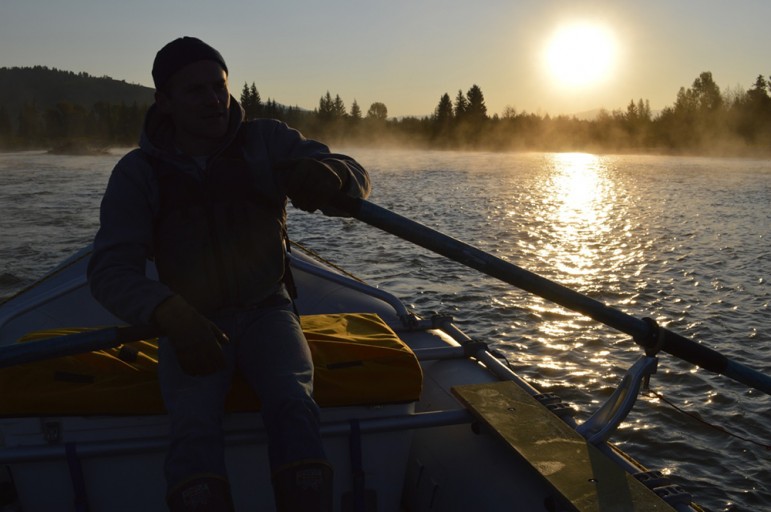
We’d set alarms for 5 a.m. I awoke on the couch in the cabin in Grand Teton National Park and looked out the picture window to see the ground blanketed with what looked like new snow, about eight inches or so. This is how fall teases us, with the promise of a 75-degree Indian summer weekend replaced overnight by early winter.
I picked up my glasses and walked to the window. We were counting on a warm, sunny Sunday to float the Snake River through the park, and had been watching the forecast, hoping this one weekend wouldn’t bring the snow and 18-degree temperatures that had hit Jackson, Wyo. a week before. I put my glasses on and saw not snow, but summer’s dried-out grass, folded over in lumps and awash in moonlight. This apparently is also how fall teases us, by making us think of winter and then taking it suddenly away.
The coffee maker whispered in the kitchen and the guys stirred in the back room, stuffing sleeping bags, shuffling gear, fiddling with headlamps. We carried packs out to the vehicles in the dark. An elk bugled somewhere off in the forest. Stars glinted faintly above the pines. We stuffed overnight gear into the car, threw daypacks into the pickup, and drove to the boat launch at Pacific Creek. The first low glow began to seep upward from the eastern horizon and the truck lights made bright streaks in the darkness as Joe backed the trailer to the river’s edge so we could slide the raft into the water. The current hushed past reflecting the sky, quick and shiny, more like oil than water.
By the time Joe and I returned from driving the shuttle the whole sky was yellowy-pink and we’d tucked our headlamps away. The sun was poised just under the lip of the hills. We pushed off, the water now transparent green instead of oily silver, and whisked downstream, Joe dipping the oars only enough to keep the raft in the current. Around the first bend we slipped into bright morning sunlight that painted the river in slashes of orange with purple shadows. Tufts of steam curled up from the surface. The oars licked the water. We huddled into our down coats and turned our faces, eyes closed, to the sunlight like lizards.
“Season of mists and mellow fruitfulness, Close bosom-friend of the maturing sun,” wrote John Keats in his 1819 poem “Ode to Autumn.” He described apple trees bending with fruit, a cider press oozing juice, and swallows gathering in the skies. Our “Ode to Autumn” today would conjure the sweet, bready aroma of sun-warmed cottonwood leaves flaring gold against the blue sky like flags of celebration for a summer well done.
We felt like the honeybees to whom Keats wrote “And still more, later flowers for the bees, Until they think warm days will never cease.”
On a gravel bar pocked with elk prints, Joe fired up his tiny camp stove. More days should start this way: pre-dawn wake up, bite of icy water on feet and ankles, first sunbeams felt against one’s face, cradled mug of hot coffee sipped to the lap of river against gravel. These are the sensations of an autumn morning in Wyoming.
After breakfast we floated on, lazy hour after hour, taking turns at the oars, and gazing at the passing peaks. Later in the morning we stripped away our coats, replaced wool beanies with brimmed caps, pushed up our sleeves, discarded shoes and socks for flip flops, rubbed sunscreen on our noses.
Part of the allure of a day trip like this was how it reminded us of our longer adventures, several-week-long river trips in Colorado and Idaho and Utah, rafts stacked with food and gear and musical instruments, night after night circled around campfires, sleeping out on beaches between the water and the stars, waking to dawn light with tousled heads like wild animals emerging from the burrows of our sleeping bags. This was one of the first floats on Joe’s new raft, a sixteen-foot grey self-bailing boat big enough for some of the rowdier western rivers. So not only were the four of us reminiscing about past trips, but also dreaming of the future adventures this craft might take us on.
We spotted a band of antelope resting on the shore. The Grand Teton loomed into view, closer around every bend, pale in the autumn haze but with each crust of snow and seam of rock etched in faint detail. The shores slipped by, and bone-dry skeletons of long-toppled trees stuck their fingers out of the water. Clear round river stones and moss-covered boulders swept below us.
Forget the take-out and the drive home. I’ll leave the story here, with us bobbing along the cold clear water under the pale blue peaks, smelling the crisp fall leaves, sun on our shoulders. Yes, at this season the ghostly image of snowfall enters our dreams, and I do encourage all Wyomingites to start watching ski films and planning hut trips and waxing ski gear. But don’t let this small window of crisp, perfect, beautiful fall days surrounding the equinox slip past uncelebrated. Find a way to cook your breakfast on a gravel bar for one last ice-rimmed morning and toast the clear flowing river and golden trees with your steamy mug.
Emilene Ostlind is communications coordinator for the Haub School of Environment and Natural Resources at the University of Wyoming and edits Western Confluence magazine, a publication of the UW Ruckelshaus Institute. Reprinted with permission from WyoFile, a nonprofit news outlet covering Wyoming people, places and policy.
